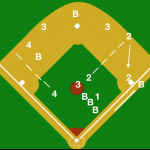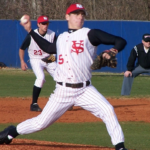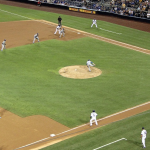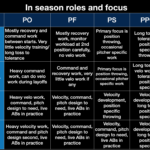Blocked vs. Random Practice
If you're anything like me, you get to the range about 15 minutes before your tee time, grab your driver, swing as hard as you can 10 times, then grab your five iron shank a few to the left, a couple to the right, then scramble over to the first tee box and proceed to have the most frustrating four and a half hours of my week.
Golf doesn't look like what I did at the range (it probably doesn't look a whole lot what I did on the course either), and my "practice" time probably didn't make me any better at all.
Just like playing infield doesn't look like "three ground balls right at you, two back hands, two forehands, and one slow roller... repeat."
Hitting doesn't look like 10 straight outside fastballs, pitching doesn't look like 6 straight curveballs, and outfield doesn't look like 8 balls hit straight over your head in a row.
Many very regimented practices have every little thing mapped out in a sequence so that players know exactly what is coming.
That is an example of blocked practice where players know what is coming and they have to perform the skill necessary to complete the task.
This type of practice is fantastic for initial skill development or when a specific skill has regressed, but it is lacking one very key component... decision making.
Before a player hits an outside pitch to the opposite field, they have to recognize the pitch and put an appropriate swing on it. Before the outfielder goes back on and catches a fly ball behind them, they have to recognized the ball is going over their head, and react accordingly.
Everything that happens in the game requires a snap decision (either conscious or subconscious) prior to executing a skill.
Once a player is proficient at a skill, coaches should introduce random practice to help him with the decision making process prior to executing the appropriate skill.
Check out our video on the difference between blocked and random practice and when and how to implement each here:
https://www.cornerstonecoachingacademy.com/blocked-and-random-practice/
Who knows, maybe that video will even help you shave a few strokes off your golf game.
More from my site
 CCA Podcast 186 – 24 infielders productive with just one coach!
CCA Podcast 186 – 24 infielders productive with just one coach! CCA Podcast 084 – Striking a good work/life balance
CCA Podcast 084 – Striking a good work/life balance CCA Podcast 117: Components of being a great pitcher
CCA Podcast 117: Components of being a great pitcher CCA Podcast 140 – Why is baseball so difficult to simulate in practice?
CCA Podcast 140 – Why is baseball so difficult to simulate in practice? CCA Podcast Episode 015: Utilizing Defensive Shifts in High School and Below
CCA Podcast Episode 015: Utilizing Defensive Shifts in High School and Below CCA Podcast 247 – Managing Two Way Players
CCA Podcast 247 – Managing Two Way Players
 Posted by Kyle Nelson
Posted by Kyle Nelson- Posted in Coaching Philosophy, Practice Organization
 May, 05, 2015
May, 05, 2015 1 Comment.
1 Comment.
Elite members login here
Check out what’s New/Hot!
Recognizing, Diagnosing, and Fixing Common Hitting Flaws eCourse The 3 metrics we tested on Blast motion sensors this year Sneak Peek Inside an Elite Q and A The batting practice continuum Elite Member’s area table of contents 50+ “Chaos” hitting drills
5 sample Chaos hitting drills FREE
Mental Skills and Culture Building The hitting pyramid Welcome Elite Member, Trey! Ideas for a pitcher first practice 12 week bat speed improvement plan Make plans this offseason to have your team playing their best baseball at the end of the year” Top 5 hitting drills to translate practice skill to game performanceHow we used Blast Motion sensors with a team in 2019
What to do if your hitters are overmatched Welcome Elite Member, Tommy! Setting your baserunners up for success Welcome Elite Member, Mike! A consulting call with Elite Member Matt FREE Web Clinic: Developing Athletic, Consistent, Extraordinary Infielders
 Coach Kyle Nelson
Coach Kyle Nelson
[…] Blocked vs. Random Practice – To me, this is the frontier in baseball coaching. So much of what we do in baseball looks nothing like the game itself. Determining when to use blocked practice and when to use random practice is HUGE in player development. […]